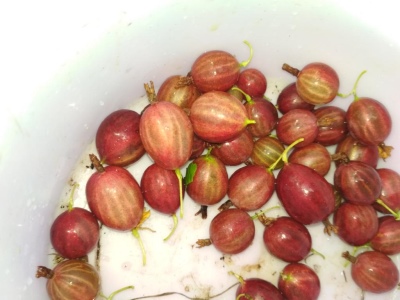
- Authors: V.V.Spirin (Vologda region, Nikolsk)
- Year of approval: 1959
- Growth type: vigorous
- Description of the bush: sprawling, powerful, dense, erect
- Escapes: thin, obliquely upward, with hanging tops
- Thorniness: weak
- Thorns: medium thickness
- Sheet: small to medium, green, glabrous, medium glossy, non-leathery, slightly wrinkled, leaf base mostly straight
- Spike location: located at the bottom of the shoot
- Flowers: small
In summer, fruits and berries are gaining popularity. Tables are bursting with a variety of choices: strawberries, wild strawberries, currants. Sweet berry gooseberry Seedling Lefora.
Breeding history
In the late 19th - early 20th centuries, gooseberries are known in Russia, but with the advent of American powdery mildew, the area of distribution decreased significantly. A large number of European varieties ruined the disease, there was a question about new, resistant samples. As a result of painstaking, complex work in 1959, the scientist Spirin in the Vologda region, on the basis of the selection of seeds by E. Lefort, bred the Seedling Lefort.
Description of the variety
Gooseberry grows in the territories of our country: the upper and lower zones. Height reaches 1 meter, densely strewn with green, shiny foliage. One feature of this shrub is that it is an ideal pollinator for other agresta varieties. Unpretentious to the environment, with proper care and watering, it gives a sufficient amount of berries.
Shrub pluses:
resistance to winter cold;
powdery mildew resistance;
fertility;
slight thorniness of branches;
withstanding high temperatures;
the fire rat is not damaged by the pest.
Minuses:
significant development of bushes;
small fruit, up to 5 g;
unresistant to septoria disease.
Characteristics of berries
The berries are painted in the original color - pink-purple. The beginning of the growth of berries is far from the base, along the length of the branch. Round or oval in shape, thin rind.
Taste qualities
The taste is sweetish dessert, with a weak aroma.
Ripening and fruiting
The bush bears fruit twice a summer. The first collection falls in June, the second time - in August. If you did not harvest on time, do not be upset, because the taste of the product will become much better.
Yield
The number of berries harvested reaches from 2 to 5 kilograms.
Landing
When choosing a landing site, it is worth considering some characteristics.
The berry loves the sun, so it is worth choosing a place where the sun's rays are present for at least half a day.
For productivity, do not forget about watering.
The soil is suitable for black earth, but it grows in loam.
Plant young seedlings in early spring, the right time is September
It is preferable to plant a bush at a slight slope, leave 2 buds in the ground, 4-5 at the top, cut off the remaining with pruning shears. Water abundantly, the plant does not tolerate chlorine, so the water should be free of impurities.

Growing and care
To increase the amount of the crop, and to reduce the incidence of disease, fertilizing is carried out in three stages.
Top dressing with nitrate to avoid nitrogen deficiency. For one shrub 40-60 grams of substance.
In the spring, in May, it is worth feeding with a solution of water and droppings, the ratio is 1: 4.
In summer, feed with water, manure and ash. For a plant of 8 liters, such a top dressing will give root growth and fruit filling.
To form a bush, it is worth considering the rule.
In the first year, remove the branches that grow downward and trim the shoots by a third.
After a year, leave formed from the old ones, cut fresh ones by a third.
Repeat the procedure annually.
Before hibernation, the plant should be prepared.
Remove leaves, branches at the very base. Pests, diseases and insects will survive the cold and attack the bush in the spring; humus or peat will help as a heater.
Top dressing of the land, in which there is no nitrogen and there is phosphorus and potassium. This will help overwinter, and in the spring will not allow the plant to deplete. Water with enough water, moist soil will keep warm better than dry soil. The main thing is not to overdo it with the amount of water, this will lead to rotting and death of the plant.



Disease and pest resistance
The gooseberry plant is attacked by pests and diseases. Some of the observed: rust, mosaic, anthracnose, septoria. Treatment with a mixture of copper sulfate, 1% Bordeaux liquid. Pests: caterpillar, aphid, glass. A solution of laundry soap or water heated to 80 degrees will help to deal with them.
Over time, the bush reaches a height when the sun does not illuminate the branches, the fruits become smaller and pests appear. Pruning will help preserve the quality of the crop, in the autumn, after hibernation, the bush will come to life, new leaves and buds will appear.

In order for the gooseberry to produce a good harvest, it is necessary to devote time to disease prevention.




































































